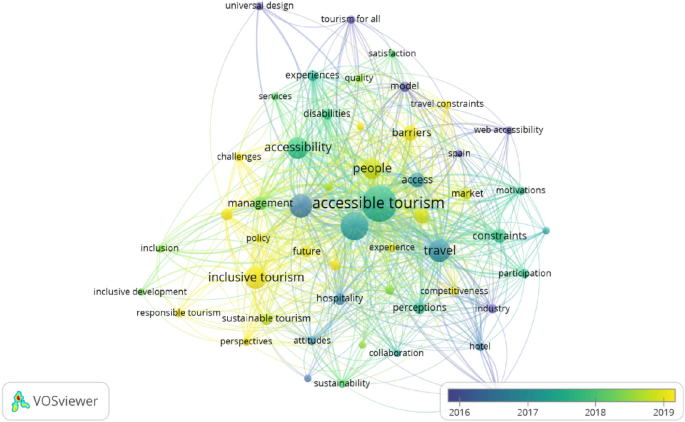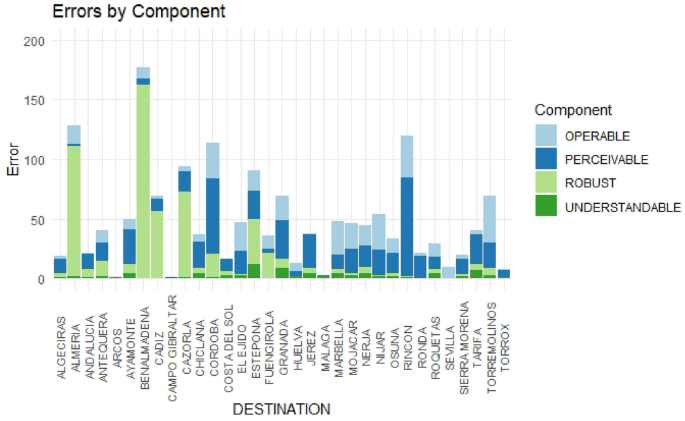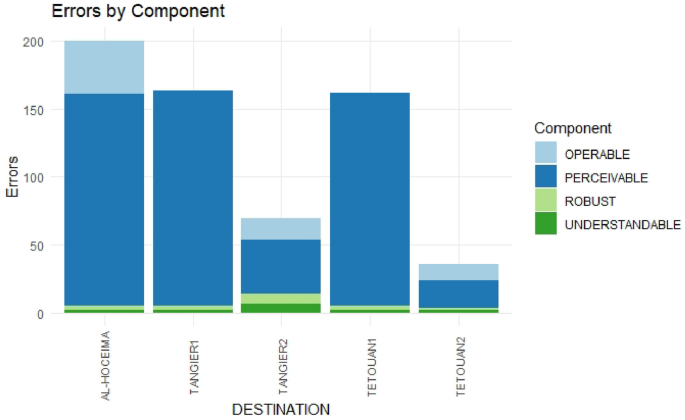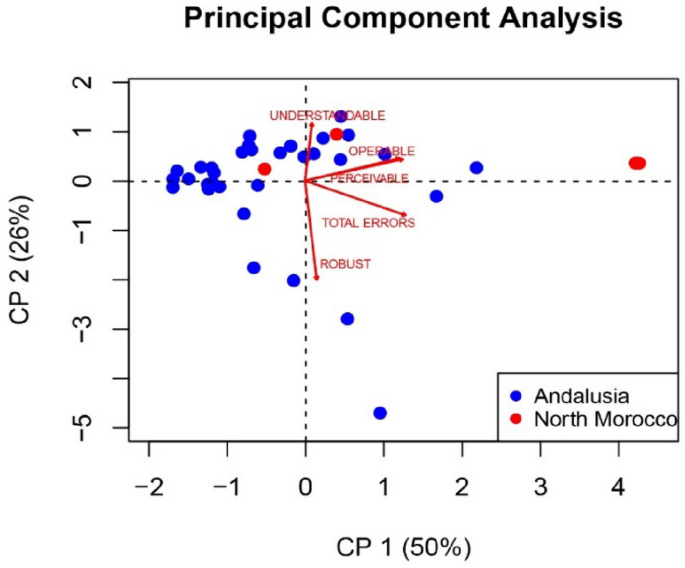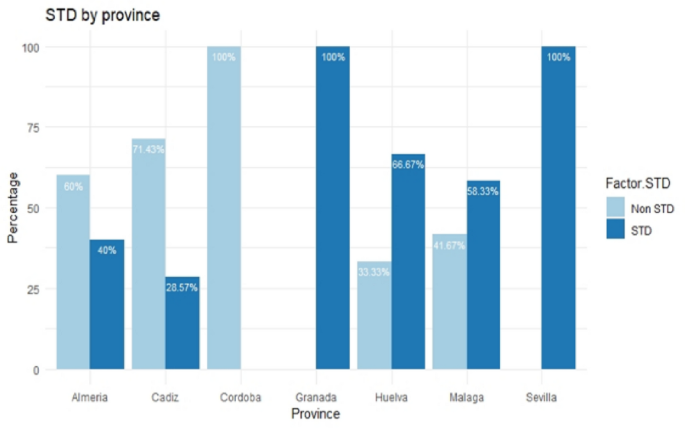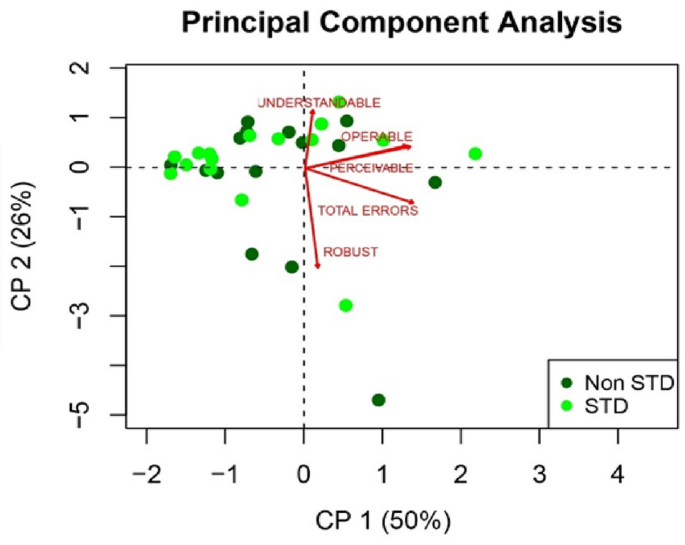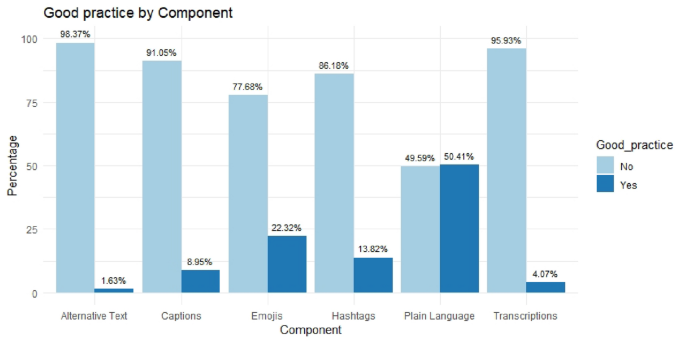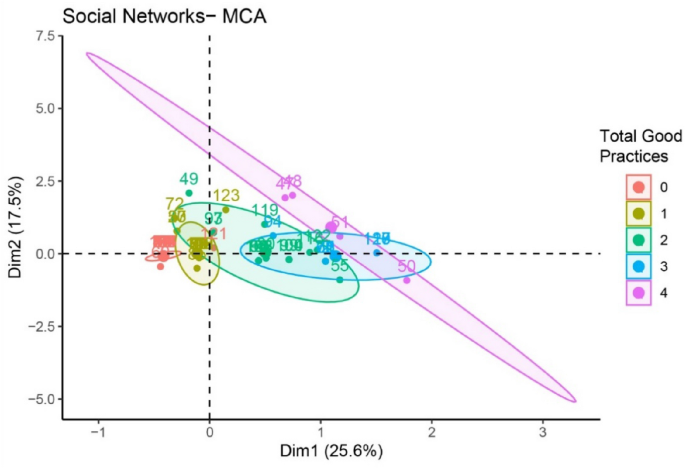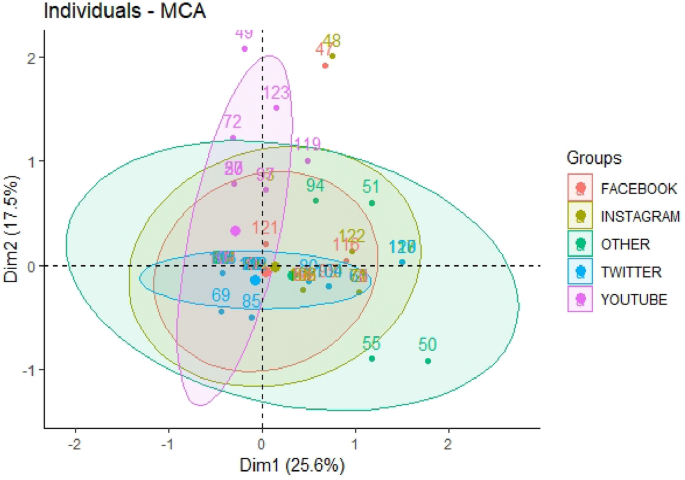Abstract
Tourists with disabilities, representing approximately 15% of the world's population, especially need everything planned for their tourist experiences. Therefore, the contents and level of digital accessibility are vital and significantly impact the final decision to travel to one destination.
This work analyses a total of 165 digital contents (152 in Andalusia and 13 corresponding to Northern Morocco) from the perspective of web accessibility and inclusive communication in social media. The method used is multidisciplinary, carrying out a series of analyses through the statistical language R, TAW as an online tool to analyse the website's accessibility and synthesise guidelines for communicating inclusively in social networks.
The main results show the scarce involvement of public bodies in inclusive communication and digital accessibility, designing content from the universal design perspective. There is no substantial difference between the two regions studied, identifying that European legislation and national regulatory framework in Andalusia's case do not favour a better level of web accessibility, although this is a mandatory aspect. Furthermore, very few differences have been noted in analysing the level of Smart Tourism Destinations when accessibility is fundamental in their conceptualisation. Finally, this research can be identified as state-of-the-art in tourism marketing as a conceptual approach and a starting point for measuring inclusive communication in social networks.
Nowadays, accessible tourism is an opportunity to be placed at the centre of recovery plans in the post-COVID-19 era. Therefore, let us facilitate more inclusive societies, using tourism as a lever to achieve this goal.
Similar content being viewed by others
Avoid common mistakes on your manuscript.
1 Introduction
Hereafter, the literature review introduces the research on Accessible Tourism, and contextualises this work. The term “accessible tourism” is relatively new in scientific research, characterised by its transversality. The databases of scientific articles in Web of Science and Scopus were analysed, searching with the terms “Accessible tourism”, “Inclusive tourism”, “Web Accessibility”, and “Inclusive Communication” both in the title and in the abstract and keywords for the selected dates, from 2000 to 2021. A total of 252 research articles have been obtained related to this topic, from the first use of these terms in 1989 to the considerable increase in scientific production related to this research topic from 2018 onwards. Focusing on the terms “Web Accessibility” and “Inclusive Communication”, the following figure shows the evolution of the most used keywords over time, where both concepts are not linked to the most relevant research topics, nodes configured by accessible tourism, accessibility or travel, among others. (see Fig. 1).
In contrast, all the terms related to “inclusive tourism”, i.e. “inclusion”, “inclusive development”, “responsible tourism”, or “responsible tourism”, are within the most current node identified in yellow in the cluster around 2019. The term “Inclusive Communication” itself is not yet represented, although work like this will help narrow this gap.
Analysing the term “Web Accessibility” in the literature review, a total of 29 research articles have been identified in the supplementary (Table 1). The selected articles are from the last decade following the criteria: articles from 2022 regardless of the number of citations; articles from 2018 to 2021 if they have at least one citation; finally, articles from 2012 to 2018 if they have at least ten citations with the aim of identifying papers that have a high level of support for their scientific contribution through the citations obtained during the last decade, as well as more current papers in recent years to analyse the current trend in this research topic. In general terms, the aspect most covered by the previous literature is tourism websites accessibility analyses through automatic tools to destinations management organisations, global airlines, hotels or event sectors. The general results showed that the Web accessibility of tourism websites is generally low. However, there is diversity according to the type of tourism activity, which means that disabled users may have substantial problems accessing websites, as seen in recent works [1, 2]. Being one of the specific objectives of this work for the specific case of Andalusia, it has been noted in full support of the results of previous work [1], that none of the websites of the smart tourism destinations fully complied with the international WCAG 2.1 framework. Moreover, as will be seen in the section dedicated to Smart Tourism Destinations in Andalusia, it has not been possible to verify a better performance in terms of web accessibility for those classified as Smart destinations than those not.
Another issue that has been extensively addressed in these previous works [3] is that the studies published mainly use manual or automatic evaluations. However, the number of studies using mixed approaches (both manual and automatic) is minimal as well as another identified gap is related to the need for studies using WCAG 2.1. In order to fill these gaps, this paper analyses both manual and automatic web accessibility under WCAG 2.1. In line with the results of some previous works [4], this paper supports the idea that countries with a long tradition of accessibility in legislative terms do not necessarily perform better in web accessibility analysis. Likewise, the recommendation to carry out comparative research work between continents is another aspect that this work addresses in line with the gaps identified by authors of previous works to complement existing research [3, 4].
Finally, the framing of this work concerning research studies shows that people with disabilities use social networks to expand their knowledge related to tourism services [5], constituting a fundamental tool for eliminating barriers through inclusive communication. Information on social networks to promote tourism services for people with disabilities is minimal. This study contributes to filling this gap by studying the level of inclusive communication used in the different social network profiles by the tourist destinations in the sample studied. To the authors’ knowledge, it is one of the first existing studies in this regard. However, it would be necessary to complement it by assessing the perception of people who experience a disability when interacting with social media platforms.
In this sense, this research addresses the challenges identified on websites and social media in terms of accessibility and inclusive communication, as well as the application that the competent administrations carry out in this area with the existing regulations in both countries. The particularity of this article lies in the fact that accessible tourism is a real opportunity for both mature and emerging destinations for different reasons. For this reason, the study area for this work was Andalusia, a region in southern Spain made up of eight provinces (some inland, such as Seville, Cordoba and Jaen, others eminently coastal, such as Huelva, Cadiz, Malaga, Granada and Almeria) and the northern region of Morocco, i.e. the region of Tangier-Tetouan-Al-Hociema (this region includes other smaller destinations such as Larache, Chef Chaouen, Ouazzane, Bab Berred and Tarquist). These are two territories in which there has been a historical relationship of economic, social and cultural cooperation, primarily in the area known as the “Círculo del Estrecho” [6]. Relations between these intercontinental territories have been strengthened in recent years, especially in the tourism sector [7], although there is still room for improvement, for example, on issues such as the one analysed here.
Proof of this is that only 9.2% of tourism facilities and services in EU countries have some level of accessibility. Furthermore, an in-depth analysis has noted that 90.8% of tourist facilities are not adequately prepared for people with special accessibility needs [8]. In the case of Morocco, mainly due to its proximity to Europe, it has a potential of 138.6 million customers and a gross turnover of 786 billion euros.
Despite these, this article focuses on the universal right to travel on equal terms, and to this end, the information available and its level of digital accessibility are fundamental. The challenges of accessible tourism in today’s digitised world require content designed to be consumed by all, regardless of personal circumstances, disabilities or temporary or permanent limitations [9,10,11]. At the same time, public promotion agencies have an opportunity to introduce the inclusive use of digital marketing in the tourism industry [12, 13].
In this regard, it must be remembered that it is crucial for tourists with special needs to have everything planned and organised before they go on a trip. Therefore, the information available and its accessibility are of vital importance. This significantly influences the final decision to travel to one destination or another. Related web accessibility is the inclusive practice of making it possible for anyone to access a website and consume its content regardless of their circumstances [14, 15].
However, this statement is difficult to address when applying established standards of eAccessibility, especially in terms of geographic area. To solve this problem, international initiatives such as the one promoted by the World Wide Web Consortium (W3C) aim to standardise websites [16, 17]. In Europe, Directive (EU) 2016/2102 on the digital accessibility of websites and apps for mobile devices of public sector bodies was published in December 2016 to harmonise the accessibility requirements for websites and apps of public bodies at the European level. In Spain, in general, and for Andalusia, the directive is set out in Royal Decree 1112/2018, of 7 September, on the accessibility of public sector websites and mobile devices. Establishing the obligation for public portals to have an Accessibility section following the model published by the European Commission (EU) 2018/1523, the EU establishes an accessibility declaration model with the information that must be provided and the requirements must be met. As for the United Nations, accessibility to information and communications was established in the Manila Declaration and Recommendations on 7 March 2003 https://www.un.org/esa/socdev/enable/maniladecl.htm. Similarly, the UNWTO digital accessibility statement has published the first international standard on accessible tourism for all, led by UNWTO, ONCE foundation and UNE https://www.unwto.org/news/publication-of-first-international-standard-on-accessible-tourism-for-all.
Morocco does not currently have mandatory legislation on the digital accessibility of public websites. The recommendations followed by some administration areas align with the standards stipulated by the W3C through (WCAG) 2.1. Furthermore, to the regulations issued by the United Nations.
As can be seen, info-accessibility is not an isolated element but a generalised pattern worldwide. On the other hand, the state of research on digital accessibility in tourism websites is limited to a few previous works [2, 4, 18,19,20,21,22].
Because of the above, the general objective of this research is to analyse the levels of digital web accessibility and social media inclusive communication of the main tourist destinations in the “Círculo del Estrecho”. Conducting a cross-cultural study this work aims to analyse the differential component between the European regulatory framework applicable to the case of Andalusia and that applicable to Morocco in the Northern region.
Based on this goal, we address the following research questions:
RQ1
What are the main good practices and problems regarding digital accessibility in Andalusian and Northern Morocco Tourism Public websites?
RQ2
Is the regulatory framework for digital accessibility in Andalusia having a positive differentiating effect on the tourism sector compared to the destination of Northern Morocco?
RQ3
In Andalusia, are Smart Tourist Destinations (STDs) improving the web accessibility of public tourism promotions bodies?
RQ4
Do tourism administrations in Andalusia and Northern Morocco communicate inclusively on social media?
2 Methods
The research method used was multidisciplinary. The multidisciplinary contribution can be interpreted as the grouping of disciplines that retain their problem-solving approach to find a solution to a common problem. In the research process, the sample under study takes into account in Andalusia, the 22 tourist points established by the National Statistics Institute (INE) https://www.ine.es/index.htm as tourist destinations, 7 of them are included in the network of Smart Tourist Destinations (DTI) (https://www.destinosinteligentes.es/destinos-inteligentes/).This gives a total of 17 initiatives in 32 tourist destinations. It should be noted that the province of Jaén does not include in the sample any tourist destination based on the two selection criteria belonging to the list of tourist destinations defined by the INE, as well as not currently having any tourist destination in the Smart Destinations Network. As for northern Morocco, in the region of Tangier-Tetouan-Al-Hociema, 5 websites and 8 profiles on social networks have been identified. Tourism promotion in Morocco is centralised in the institutional portal of the Moroccan Ministry of Tourism, which does not have promotional websites or profiles on social networks. It should also be noted that there is currently no STD initiative in Northern Morocco, neither with the framework followed in Spain, the SEGITTUR methodology [23], nor with other frameworks, although there is a growing interest in these issues. Thus, has been obtained a final sample of 37 destinations in Andalusia and Northern Morocco has been obtained, identifying 37 official websites (33 in Andalusia and 5 corresponding to Northern Morocco) and 127 official profiles on social networks (119 in Andalusia and 8 corresponding to Northern Morocco). A total of 165 digital contents (152 in Andalusia and 13 corresponding to Northern Morocco) will be analysed from digital accessibility and inclusive communications perspectives.
Thus, during this process, techniques and tools of data science have been used through the R statistical programming language. TAW, was used to analyse web accessibility in non-social reach, following a decalogue of good practices on accessibility in social reach to analyse whether public bodies promoting tourism communicate inclusively on social networks. Finally, a comparative study through a cross-cultural analysis of the results obtained for both Andalusia and Northern Morocco was conducted. For this purpose, the statistical R programming was used to perform linear regression analysis, principal component analysis for the quantitative variables mainly related to digital accessibility errors, and correspondence analysis for the factor variables related primarily to good practices of inclusive communication in social networks.
TAW is an automatic online tool to analyse the accessibility of websites (https://www.tawdis.net/index.), it was created by the CTIC Foundation, Parque Científico Tecnológico, Gijón, Asturias, Spain, taking as a technical reference the Web Content Accessibility Guidelines (WCAG 2.1) of the W3C consortium (https://www.w3.org/). TAW has been the reference tool in Spanish-speaking countries for more than 15 years. However, it is a checking tool suitable for web pages whose language is English. In our study, by using both English and Spanish pages for the cases that do not have translated pages it is understood that it is the tool that best adapts to our specific reality under study.
The main approach when applying accessibility to a website should be to reach the highest possible level. The levels of digital accessibility of a website are measured with the WAI-W3C Web Content Accessibility Guidelines WCAG 2.0, classified as follows:
-
WCAG 2.1 A. Meets all Priority 1 checkpoints. Websites that do not satisfy this checkpoint will result in one or more groups of users finding it impossible to access the information;
-
WCAG 2.1 AA. Websites that do not satisfy this checkpoint will result in one or more groups of users encountering difficulties in accessing the information;
-
WCAG 2.1 AAA. Websites not satisfying this checkpoint will result in one or more user groups encountering difficulty accessing the information.
Digital accessibility is based on four principles:
-
PERCEPTIBLE (perceived by all people). Information and user interface components must be presented to users in ways they can perceive. This means that users must be able to comprehend the information being depicted: It can’t be invisible to all their senses;
-
OPERABLE (all people can interact with it). The interface cannot require interaction that a user cannot perform;
-
UNDERSTANDABLE (messages understandable by everyone, especially in social networks). Users must be able to understand the information as well as the operation of the user interface;
-
ROBUST (ICT products and services compatible with other types of systems or assistive technologies that facilitate accessibility). As technologies and user agents evolve, the content should remain accessible and compatible with a range of assistive technologies.
The sum of the total number of errors committed in the above variables is considered in the analysis as an aggregate variable called Total Errors.
Related to the decalogue of good practices for inclusive communication in social media, the base of the model recently published by Alexa Heinrich [24] has been followed. It is an eminently practical guide developed considering the experience of both accessibility experts and disability experts https://www.accessible-social.com/. Accessible Social is committed to being accessible to everyone who wishes to learn more about inclusive best practices for social media ongoing accessibility efforts work towards conforming to the Web Content Accessibility Guidelines (WCAG) version 2.1, level AA criteria. These guidelines help make web content accessible not only to users with sensory, cognitive, and mobility disabilities, but also ultimately to all users, regardless of ability. The main points to be checked under this framework are divided into the following sections: Copy, Images and Audio-visual (see Table 1).
The methodology described above is then applied, analysing web accessibility and the level of inclusive communication on social networks both in the main tourist destinations in Andalusia and Tangiers, Tetouan and Al-Hocima, in the northern region of Morocco.
3 Results
This section presents the results from this study, related to Web Digital Accessibility Analysis and Social Media Accessibility Analysis.
3.1 Webs digital accessibility analysis
First, a database was created containing all the public tourism promotion websites of the tourist destinations in both regions. The database will also support the analysis of digital accessibility, including the results provided by TAW to specify the total number of accessibility errors for each website under study. The different digital accessibility principles, i.e. Perceivable, Operable, Understandable and Robust, were checked for each website (see supplementary Table 2 Destination’s webs digital accessibility analysis).
3.1.1 Accessibility modules by regions and provinces
Next, data of the websites in Andalusia and Northern Morocco that have information on accessible tourism through a specialised information module on accessible tourism and/or decalogue of digital accessibility was gathered (see Table 2).
As seen in Table 2 above, the websites with an information module on accessible tourism or a digital accessibility decalogue represent only 36.36% of the total in Andalusia. In Morocco, on the other hand, after analysing all the websites in the northern region, there are no modules with specialised information on this market segment. Andalusia’s improved positioning is due to a digital accessibility decalogue that is mandatory for all public promoting websites. In addition, of the 12 websites with the mandatory digital accessibility decalogue, half (50%) have specialised content or information on accessible and inclusive tourism. It is worth highlighting the lack of information on accessible tourism on the institutional portals of such emblematic destinations as Malaga, Marbella, Granada and Seville.
3.1.2 Web accessibility errors by regions and provinces
The level used to analyse web accessibility in the public tourism promotion portals of Andalusia and Northern Morocco is the W3C Standard Web Content Accessibility Guidelines (WCAG) version 2.1, level AA. It included a wide range of guidelines to make content more accessible for people with disabilities: blindness and low vision, deafness and hearing loss, limited movement, speech disabilities, photosensitivity, and combinations of these, and some accommodation for learning disabilities and cognitive limitations, using TAW as an analysis tool to measure web accessibility by total errors detected on sites’ HTML and CCS languages. As a quantitative variable (Total Errors), a mean and standard deviation analysis was performed for each of the two geographic locations or regions (see Table 3).
As shown in the previous figure, the average total errors of the websites analysed in Andalusia are 48.88. At the same time, 142.40 are the average errors of the websites available in the North of Morocco. Seville and Cadiz have the lowest number of errors, averaging 21.33 and 29.28, respectively.
Continuing with the analysis under the WCAG 2.1 AA standard, each kind of error has been analysed, for each principle: Robust, Understandable, Operable and Perceivable, by each destination in Andalusia and the north of Morocco as shown in the figures below (see Figs. 2, 3).
As the previous figure shows, perceivable and operable are the principles with the most errors, with 576 and 382 errors, respectively, with a similar distribution among the different tourist destinations in Andalusia, except Rincón and Córdoba. While the minor errors are related to the principles understandable and robust with 91 and 562, respectively, the latter is on the level as the two most frequent error categories; this is because only two destinations, Benalmádena and Almería, account for almost 50% of the total number of errors identified in the robust category with 271 errors out of the total.
As seen in the previous figure, perceivable and operable are the principles with the most frequently occurring errors on the websites analysed in the destination of northern Morocco. Thus, the most significant digital accessibility problems were identified as the scarce use of alternative texts for images and other accessibility problems linked to the components of the interfaces. In the other two categories, understandable and robust, the errors are more limited, from this, a good performance in the comprehension of the content can be deduced, which is generally interpreted reliably by a wide variety of users, including technical aids.
Complementing the previous analysis, the analysis went deeper into the fundamentals of the accessibility variables of the WCAG 2.1 AA standard: Robust, Understable, Operable and Perceivable, through two complementary analyses. These in a linear regression model to determine which variables are related to digital accessibility and a principal component analysis (PCA) through which the relationship between these variables, that explains digital accessibility, has been analysed. The linear regression model is set out as follows:
Model_Digital_Accessibility = lm(TOTAL_ERRORS ~ ROBUST + UNDERSTANDABLE + OPERABLE + Perceivable_estandar + ACCESSIBILITY_MODULE + REGION, data = Webs_Digital_Accesbility_Analysis).
Firstly it has proceeded to standardise the scale of the different types of errors. In the specific case of Perceptible, the number of images on the respective websites has also been considered because most images have a high potential number of errors. In this way, it has not been penalised large portals such as https://www.visitmorocco.com/en or https://www.andalucia.org/en/home, which depend on the Ministry of Tourism of Morocco and Turismo Andaluz, a public promotional entity dependent on the Junta de Andalucía (Andalusian Regional Government).
The model’s outcome is statistically significant, with an R2 of almost 90%. When performing the Shapiro test, it was indicated that the independent variable under study in the Total_Errors model does not follow a normal distribution, which is why we performed a Wilcox test to check the statistical significance of the means of this variable in Andalusia and Morocco and found it to be significant. Therefore, the variable Region is significant, so it can be argued that the geographical location, Andalusia or Northern Morocco, influences the level of digital accessibility of the websites analysed.
In this order, the statistically significant parameters or estimators are Operable, Robust and Perceivable_Standardized. At the same time, Understandable is not significant, a situation that is explained by the fact that the average number of errors of the variable is 2.81, while the errors related to the variables Perceivable_Standardized, Robust or Operable are 29.46, 15.59 or 13.92, respectively. Therefore, it is not that Understandable is not an essential characteristic of digital accessibility, but rather that in the websites analysed, there are fewer errors in this variable compared to the others studied.
Finally, a principal component analysis (PCA) was performed. Principal component analysis is one of the most widely used multivariate data analysis methods that allow us to investigate multidimensional data sets when dealing with quantitative variables, reducing the analysed variables to two principal components, PC1 and PC2, which describe, in this case, more than 75% of the original variance (see Fig. 4).
The previous figure shows how the websites relate to the variables that explain digital accessibility. The analysis works in practice as a digital accessibility performance index, where the further to the right on the abscissa axis, the greater the number of total errors the analysed website will have. Also, it identifies the variables Perceptible, Robust and Operable as the most significant influence on the total number of errors and worse relative performance for tourism promotion websites in Northern Morocco.
In the following subsection, for the specific case of Andalusia, the question of some tourist destinations working within the framework of Smart Tourism Destinations has been analysed.
3.1.3 Smart tourism destinations in Andalusia
As a consequence of the proliferation since 2014 of Smart Tourism Destination (STD) initiatives linked to the development of smart cities [25,26,27], the variable STD in the particular case of Andalusia has been included in our study to analyse whether the process of converting a mature mass destination into STD has any relationship with better performance on the levels of digital accessibility of tourism promotion websites. Even more so when, by definition, one of the fundamental pillars of smart destinations is accessibility.
From the sample under study, 53.13% of Andalusia´s destinations are immersed in converting to STD. Deepening the distribution of STD initiatives in the provinces of Andalusia (see Fig. 5).
The figure above shows the distribution by provinces of the current initiatives launched for developing STDs in Andalusia. Malaga, Seville and Cadiz are the Andalusian provinces with the highest number of STD initiatives. Cordoba, together with Jaén, the fewest, with none. In the case of Jaén, it must also bear in mind that it does not have a tourist destination considered by the INE, which is why it is not represented in the above graph. This is because the development of STDs is primarily linked to mature sun and beach destinations. Supplemented the above data by performing a principal component analysis for this factor (see Fig. 6).
The previous figure has been analysed through principal components of the quantitative and multidimensional data of supplementary (Table 2), developing factors that will be used later in a modelling method through linear regression. As shown, no pattern in the point cloud differentiates STD and NON-STD behaviours, which means that it cannot identify a better performance of these destinations that do not work within the STD framework than those that do. Therefore, the STD variable is not a positive differential component concerning digital accessibility.
3.2 Analysis of inclusive communication in social networks
Firstly, a database has been compiled, which includes the profiles on social networks used by tourist destinations in Andalusia and Northern Morocco to promote tourism content (see supplementary, Table 3 Tourist destinations’ social media analysis).
In supplementary (Table 3), profiles in social networks have been classified geographically by region, province and city. In some cases, the managing body of the tourist destination corresponds to a group of cities or provinces; for these cases, we proceeded with an NA, indicating that this data is unavailable. We carried out a manual collation task for each social network to identify cases of good practices of inclusive communication in their tourism promotion content. These good practices include the appropriate use of the following qualitative variables: Plain Language, Alternative Text, Captions, Transcriptions, Hashtags and finally, limited use of Emojis. The database includes the date the analysis was done, delimiting this study in time.
3.2.1 Inclusive communication, descriptive and correspondence analysis
In this part of the study related to social network analysis, an initial descriptive analysis of the variables that make up the total of good practices has been conducted. In addition, it complements it with a correspondence analysis, as these are qualitative variables or factors, to find out the tendency of the relationship between the different variables, if there are any (see Figs. 7, 8).
As shown in the previous figure, the use of plain and informative text is the most widespread good practice, although it accounts for only half 50.41% of the copies analysed. The use of other good practices of inclusive communication is considerably reduced, and in some of the variables analysed, they are almost anecdotal. This is the case with alternative texts, a good practice to facilitate reading images by screen readers, limited to 1.63% of the profiles analysed, or the transcription of audiovisuals, with only 4.07%. Subtitling is another good practice of inclusive communication on social media that should be encouraged, as it is only presents 8.95% of the social media profiles analysed. Even practices that are simpler a priori to implement are being minimally employed, such as the use of hashtags to classify contents and facilitate their search with 13.82%, or the limited use of emojis so as not to interrupt the reading sequence of screen readers frequently, with the appropriate use of emojis being a practice found in 22.32% of the contents analysed.
Figure 8 shows a correspondence analysis of the good practices of inclusive communication on social networks by the destinations belonging to the sample under study.
As shown in the previous figure, the use of good practices in inclusive communication is reflected in the graph in the right-hand area of the ordinate axis. The variable Region corresponding to the North of Morocco is also relevant in this area. On the other hand, the worst performance of these variables is located on the left, with profiles belonging mainly to destinations in Andalusia. Regarding inclusive communication, based on the decalogue of good practices and the sample under study, Northern Morocco is in a better relative position than Andalusia. However, one must bear in mind that the total number of profiles analysed is much higher in the case of Andalusia, depending on different public entities. In the case of Morocco, the profiles belong mainly to the public accounts of the Moroccan Ministry, thus organising the communication process in a more centralised way.
At this point, the profiles of tourist destinations on social networks will be analysed, classifying them into five groups, from those that do not comply with any good practices to those that comply with four good practices in terms of inclusive communication (see Fig. 9).
The previous figure shows how the groups of profiles with the worst performance with 0 or 1 good inclusive communication practices are located in the left area, with a reasonably close position. In contrast, the groups of profiles in social networks with 2 to 4 good practices are in the right area of the graph. Visually, the groups or clusters with the worst results are those with the highest number of members, confirming how little interest is devoted to the issue of inclusive communication by tourist destinations. To illustrate this point, we complete the previous quantitative analysis with a qualitative analysis based on the good practice guide for inclusive communication on social networks. In this case, collecting through the UX Check some of the worse practice cases examples trying to limit them (see supplementary, Table 4). A complimentary comment to the previous table can identify a generalised lack of good practices in inclusive communication through the social media profiles of tourist destinations, in some cases, a profound lack. For example, only 1.63% of images use alternative text or a meagre 8.94% use video subtitles. However, the performance of profiles from Northern Morocco is somewhat better, considering that the number of profiles is lower than those from Andalusia. The room for improvement in communicating more inclusively on social networks is enormous for both regions.
3.2.2 Inclusive communication, linear regression analysis
The present section has analysed inclusive communication through social media destinations profiles in Andalusia and North Morocco with a linear regression model where each variable belonging to good practices is the estimator of this explanatory variable. The variables region and social network were added, and their statistical significance was analysed, using the following regression model:
Model_Comunicate_Inclusively = lm (TOTAL_GOOD_PRACTICES ~ `PLAIN LANGUAGE` + `ALTERNATIVE TEXT` + CAPTIONS + TRASNCRIPTIONS + HASHTAGS + EMOJIS + REGION + Network, data = Social_Media_Analysis).
In order to include the latter variable, social networks, a preliminary analysis of mean and standard deviation and correspondence analysis has been conducted (see Fig. 10).
In this first approximation, Instagram and Facebook are the social networks with the highest number of good inclusive communication practices, along with Pinterest, significantly the most inclusive in the group of other social network profiles (OTHER). In contrast, Twitter and YouTube are positioned last, shown as the worst-performing networks to the left of the graph. Social networks such as Facebook and Instagram are positioned to the right, with their position in the diagram depicting a better performance in inclusive communication. The sphere represented by Others reflects the level of inclusive communication of the group of minority social networks in use by the tourist destinations analysed: Flickr, Issuu, Spotify, Blogger, LinkedIn and Pinterest. However, they are the ones that accumulate the highest number of good practices in inclusive communication. This is mainly due to the high performance of LinkedIn and Pinterest. Both social networks perform better in audio videos with subtitles, transcriptions, informative copies and no abusive use of emojis.
Focusing on the regression model, the variables that make up the total of good practices, i.e. plain language, alternative text, captions, transcriptions, hashtags and emojis are significant as expected, as each variable forms a necessary component to communicate inclusively. Concerning the region and the level of good practices in social media, it must be noted the better performance of social media profiles of the main destinations in Northern Morocco, Tangier, Tetouan and Al-Hocima, with an average of two good practices per profile. At the same time, Andalusia has a low average of just one good practice per social media profile (see Fig. 11).
In the previous figure, the outliers in Andalusia are the profiles that communicate more inclusively on social networks, taking into account the sum of both regions, coinciding with the destination of Malaga and Nerja in the province of Malaga.
4 Discussion
4.1 1st phase discussion. Website digital accessibility analysis: accessibility modules by regions and smart tourism destinations in Andalusia
Taking into account the averages and correlations obtained in the previous section, either the limitations presented in the international context, the following reflections are considered relevant to understand the current state of this subject.
According to the results presented in this study, Table 2 shows that of the 33 websites analysed in this article for Andalusia, only 12 websites (36.36%) refer to accessibility or accessible tourism. In contrast, the rest of the websites, i.e. 21, do not make any reference, representing 63.64% of the total. Comparing this study with the data presented [2], among the results of a total of 19 websites analysed in Portugal, the territories with references to accessibility or accessible tourism are only 10, which represents 53.63% of the total. Thus, better relative performance can be seen concerning digital accessibility corresponding to the websites of Andalusian tourist destinations. In this regard, it should be borne in mind that Portugal has a long history in favour of digital accessibility, as it was one of the first countries to become a member of the accessibility guidelines of the World Wide Web Consortium (W3C).
Regarding the most common web accessibility errors identified in the pages analysed for Andalusia and Northern Morocco, the results obtained and shown in Figs. 2 and 3 highlight those related to Perceptible, Robust and Operable. In this case, the results coincide with the work carried out in the framework of web accessibility for Portugal [2, 18, 20]. Regarding the understandable principle, some problems and warnings were identified, as shown in Fig. 2, the web accessibility error with the most insignificant impact on the web pages analysed. This low average of accessibility problems linked to the comprehensibility principle is consistent with previous work [21].
The results are focused on the web accessibility of public tourism promotion bodies. As mentioned in the methodology, the most relevant destinations in Andalusia and the north of Morocco have been selected, for different reasons, as seen in Table 1 (supplementary). After carefully studying the state of the art, it can be appreciated that some works analyse the web accessibility of public and private entities in the value chain of a tourist destination. These are museums, hotels or leisure activities websites [18, 19]. Recent works confirm that more attention is given to the analysis of digital accessibility in official tourism organisations’ websites and Municipal websites, as shown in [3]. In this sense, there is no previous reference to analyse the accessibility of the official websites of the “Círculo del Estrecho” tourist destinations.
The results aim to raise awareness among the managing bodies of tourist destinations in Andalusia and northern Morocco of the importance of increasing the levels of digital accessibility of websites in both regions for several reasons. Firstly, in the case of Andalusian destinations, the minimum legal requirements still need to be met in many cases. Secondly, in both regions, few websites have a specialised information module on accessible tourism or even a digital accessibility decalogue, even though the latter is compulsory. Thirdly, concerning the northern region of Morocco, no information related to accessible tourism has been identified. Therefore, in the case of this region, web accessibility should be addressed from the initial process—design and implementation—based on international standards of digital accessibility, thus highlighting the level of web accessibility and good practices of inclusive communication on social networks in Malaga, Andalusia as an accessible destination. This destination presents an above-average performance in both parameters of this study; despite this, there is still significant room for improvement since, as shown in Table 2, it lacks reference to accessible tourism on its official website.
4.2 2nd phase discussion. Analysis of inclusive communication in social networks
The comparative framework with previous works must be more present in this new concept of inclusiveness in social networks. Some studies include the concept of inclusion from the perspective of branding [28] or the language used [29] but not from analysing the level of inclusive communication on social networks by compiling the good practices used for tourist destinations. In this sense, as shown in supplementary (Table 3), the results provided in this work aim not only to raise awareness among the managing bodies of tourist destinations in Andalusia and northern Morocco but also to encourage the tourism sector itself to reflect on the importance of increasing the levels of inclusive communication for three main reasons. Firstly, all tourists, regardless of their disabilities or permanent or temporary limitations, have the right to consume the promotional content generated by tourist destinations through social networks without discrimination. Secondly, communicating more inclusively will make it easier for tourist destinations to reach more tourists and, therefore, more potential customers. Third, communicating inclusively the content generated by tourist destinations facilitates the work of organic positioning of digital content at the end of the destination itself.
5 Conclusions
Answering the first research question, the connection between web accessibility and inclusive communication concepts leads to cross-cutting approaches based on concepts such as universal design. In this sense, in a first approximation, these terms are receiving increasing attention from researchers and communication professionals. However, there is still a considerable margin for improvement, as this paper shows. Regarding info-accessibility, a considerable need for digital accessibility on promotional websites of the main tourist destinations in Andalusia and Northern Morocco has been identified. Likewise, there is a critical need for awareness-raising and training for professionals in charge of communication within the tourism marketing function. Related to the most significant digital accessibility errors is the general lack of alternative texts for the images included on the destinations’ websites in both regions. However, Andalusian websites have a slightly higher level of digital accessibility than the northern region of Morocco. This circumstance should not hide the significant shortcomings in terms of digital accessibility which have been detected in the websites of Andalusian destinations. Websites with an accessible tourism information module or a digital accessibility decalogue only represent 36.36%, which should be mandatory for all of them according to regulations.
Concerning the second question, related to the comparison of the websites of tourist destinations in the Strait of Gibraltar, it can be stated that there are no significant differences, highlighting the shortcomings of many websites of destinations in Andalusia not complying with the mandatory legal requirements. The point to note is that the mandatory legislation emanating from the European Union and included in the Spanish regulatory framework (in the case of Andalusia) is not offering a significant differential component in terms of digital accessibility in their websites of public tourism promotion.
Regarding the third research question, currently, a significant number of initiatives in mature mass tourism destinations in Andalusia focused on accessible tourism, supported by new models of tourism management such as Smart Tourism Destinations (STDs). Although the analysis results are conclusive, they do not identify a better performance of the tourist destinations included within the STDs framework than those that do not, which is even more striking when accessibility is a fundamental pillar in the smart destinations. At this point, the component to highlight is that STDs must develop into more accessible tourist destinations by conceptualisation.
Focusing on inclusive communication practices in Andalusia and Northern Morocco as the fourth research question, minimal performance is identified, possibly due to the need for more awareness of this emerging concept in both destinations. Thus, there is a strong need for good practice in using alternative texts to describe images beyond those self-generated by some platforms. The misuse of emojis is widespread hindering the readability of the technologies on which screen readers. The inappropriate use of hashtags frequently mixed with the copy itself or the non-use of the CamelCase style makes screen readers’ work difficult. For all these reasons, there is a considerable gap in the use of good inclusive communication practices, which could also represent an opportunity for those destinations that are increasingly interested in the accessible tourism segment. Currently, most social networks offer help pages to design content that everyone can consume from the universal design paradigm [30,31,32,33,34,35,36,37,38,39,40,41,42,43,44,45,46].
The originality of this work is that it represents the first analysis of the accessibility of the websites of the tourist destinations of the “Círculo del Estrecho”, and, more specifically, it is the first time that the northern region of Morocco has been analysed. Moreover, this study represents a step forward compared to previous studies, which were limited to digital accessibility. However, this article opens up a new line of research by analysing inclusive communication on social networks. This research will be significant in tourism marketing due to its conceptual approach and as a starting point for measuring inclusive communication in tourism destinations and social networks.
As a limitation of this work, we can identify several different stages of development of tourist destinations on both sides of the Gibraltar Strait and different regulatory levels. However, the most significant is the difference in tourism management models in both regions, which has led to a significant difference in the number of websites and social network profiles to be analysed for each case. Therefore, future studies should consider the current trends of digital content consumption through any device, considering both the concepts of Web Responsive Design [47] and Mobile First [48]. We must recognize that, at present, the most significant number of searches and digital content consumption is done through mobile phones.
Finally, accessible tourism in general and digital accessibility and inclusive communication, as part of social sustainability, are fundamental for transforming tourism destinations. Future work should include indicators to measure these variables in the framework of recent studies on measuring the sustainability of tourism destinations [49].
References
Fernández-Díaz, E., Jambrino-Maldonado, C., Iglesias-Sánchez, P.P., de las Heras-Pedrosa, C.: Digital accessibility of smart cities-tourism for all and reducing inequalities: tourism agenda 2030. Tourism Rev. (2022). https://doi.org/10.1108/TR-02-2022-0091. (ahead-of-print)
Gonçalves, M.J., Camarinha, A.P., Abreu, A.J., Teixeira, S.F., da Silva, A.F.: An analysis of the most used websites in Portugal regarding accessibility web in the tourism sector. Int. J. Inf. Syst. Tourism (IJIST) 5(1), 19–28 (2021). https://doi.org/10.1007/978-981-15-2024-2_13
Teixeira, P., Eusébio, C., Teixeira, L.: Diversity of web accessibility in tourism: evidence based on a literature review. Technol. Disabil. (2021). https://doi.org/10.3233/TAD-210341. (Preprint)
Domínguez Vila, T., Alén González, E., Darcy, S.: Accessibility of tourism websites: the level of countries’ commitment. Univ. Access Inf. Soc. 19(2), 331–346 (2020). https://doi.org/10.1007/s10209-019-00643-4
Altinay, Z., Saner, T., Bahçelerli, N.M., Altinay, F.: The role of social media tools: accessible tourism for disabled citizens. J. Educ. Technol. Soc. 19(1), 89–99 (2016)
Gozalbes, E., Parodi, M. J.: Miquel Tarradell y la arqueología del Norte de Marruecos. Arqueología y turismo en el Círculo del Estrecho, 105–127. https://www.academia.edu/download/34380604/906244687_26102011122252.pdf#page=200 (2011). Accessed 05 May 2022
Sánchez, J.A.L., Garrido, M.A.: Análisis de la percepción turística en la región Tánger-Tetuán (Marruecos). Cuadernos de turismo 33, 173–198 (2014). (ISBN: 978-84-15454-35-9)
Wołek, M.: Research for TRAN committee-transport and tourism in Poland, EPRS: European Parliamentary Research Service. https://policycommons.net/artifacts/1335734/research-for-tran-committee/1942437/ (2018). Accessed 15 May 2022
Richards, V., Matthews, N., Williams, O. J., Khan, Z.: The challenges of accessible tourism information systems for tourists with vision impairment: sensory communications beyond the screen. In: ICT tools and applications for accessible tourism, pp. 26–54. IGI Global (2021). https://doi.org/10.4018/978-1-7998-6428-8.ch002
O’Dell, L.: Disabled TikTokers demand captions as the app is still inaccessible to them. Indy100. https://www.indy100.com/news/captions-tiktok-disability-accessibility-campaign-b1798172 (2021, February 6). Accessed 09 June 2022
Lewis, E.: Verizon Media and Publicis Media find viewers want captions. 3Play Media. https://www.3playmedia.com/blog/verizon-media-and-publicis-media-find-viewers-want-captions/ (2019, November 7). Accessed 14 June 2022
Gupta, G.: Inclusive use of digital marketing in tourism industry. In: Satapathy, S., Bhateja, V., Somanah, R., Yang, X.S., Senkerik, R. (eds.) Information systems design and intelligent applications, vol. 862, pp. 411–419. Springer, Singapore (2019). https://doi.org/10.1007/978-981-13-3329-3_38
Aguirre Montero, A., López-Sánchez, J.A.: Intersection of data science and smart destinations: a systematic review. Front. Psychol. (2021). https://doi.org/10.3389/fpsyg.2021.712610
World Health Organization.: Deafness and hearing loss. World Health Organization. https://www.who.int/en/news-room/fact-sheets/detail/deafness-and-hearing-loss (2021, April 1). Accessed 17 Jan 2022
World Health Organization.: Vision Impairment and blindness. World Health Organization. https://www.who.int/news-room/fact-sheets/detail/blindness-and-visual-impairment (2021, October 14). Accessed 17 Feb 2022
W3C Web Accessibility Initiative (WAI).: (2022, January 27) Web accessibility laws and policies. W3C Web Accessibility Initiative (WAI). https://www.w3.org/WAI/policies/. Accessed 25 Feb 2022
W3C Web Accessibility Initiative (WAI).: Web content accessibility guidelines (WCAG) overview. W3C Web Accessibility Initiative (WAI). https://www.w3.org/WAI/standards-guidelines/wcag/. Accessed 31 Jan 2022
Gonçalves, M.J.A., Camarinha, A.P., Abreu, A.J., Teixeira, S., da Silva, A.F.: Web accessibility in the tourism sector an analysis of the most used websites in Portugal. In: Rocha, Á., Abreu, A., de Carvalho, J., Liberato, D., González, E., Liberato, P. (eds.) Advances in tourism, technology and smart systems, vol. 171. Springer, Singapore (2020). https://doi.org/10.1007/978-981-15-2024-2_13
Singh, R., Ismail, A., Sibi, P.S., Singh, D.: Compliance of accessibility in tourism websites: a pledge towards disability. J. Hosp. Tourism Insights (2020). https://doi.org/10.1108/JHTI-05-2020-0092
Silva, F.M., Borges, I.: Digital accessibility on institutional websites of Portuguese tourism. In: Ratten, V. (ed.) Technological progress, inequality and entrepreneurship. Springer, Cham (2020). https://doi.org/10.1007/978-3-030-26245-7_5
Eusébio, C., Teixeira, L., Teixeira, P., Caneiro, M.J., Lemos, D., Silveiro, A.: The state of web accessibility for tourists with disabilities: a comparative study between different tourism supply agents. Disabil. Rehabilit. Assist. Technol. (2021). https://doi.org/10.1080/17483107.2021.1941313
Kous, K., Polančič, G.: An empirical investigation of the accessibility of official European tourism websites. In: ICT tools and applications for accessible tourism, pp. 169–195. IGI Global (2021). https://doi.org/10.4018/978-1-7998-6428-8.ch008
SEGITTUR.: Informe destinos turísticos inteligentes. https://www.segittur.es/opencms/export/sites/segitur/.content/ga-lerias/descargas/proyectos/Libro-Blanco-Destinos-Tursticos-Inteligentes-ok_es.pdf (2015) Accessed 5 Jan 2022
Alexa Heinrich: Accessible Social hub for professionals interested in inclusive and accessible communication for people with disabilities mainly focuses on social media. https://www.accessible-social.com/ (2022). Accessed 14 Feb 2022
Boes, K., Buhalis, D., Inversini, A.: Conceptualising smart tourism destination dimensions. In: Tussyadiah, I., Inversini, A. (eds.) Information and communication technologies in tourism 2015, pp. 391–403. Springer, Cham (2015). https://doi.org/10.1007/978-3-319-14343-9_29
Buhalis, D., Amaranggana, A.: Smart tourism destinations enhancing tourism experience through personalisation of services. In: Tussyadiah, I., Inversini, A. (eds.) Information and communication technologies in tourism 2015, pp. 377–389. Springer, Cham (2015). https://doi.org/10.1007/978-3-319-14343-9_28
Gretzel, U., Sigala, M., Xiang, Z., Koo, C.: Smart tourism: Foundations and developments. Electron. Mark. 25(3), 179–188 (2015). https://doi.org/10.1007/s12525-015-0196-8
Ivars-Baidal, J., Celdran Bernabe ´u, M. A., & Femenia-Serra, F.: Guıa de implantacion de destinos turísticos inteligentes de la comunitat valenciana. http://hdl.handle.net/10045/74386 (2017). Accessed 5 Jan 2022
Machado, P.: Accessible and inclusive tourism: why it is so important for destination branding? Worldwide Hosp. Tourism Themes (2020). https://doi.org/10.1108/WHATT-07-2020-0069
Gutiérrez-Artacho, J., Olvera-Lobo, M. D. O.: Transcreation in digital tourism information: an inclusive language approach. In: Promoting social and cultural equity in the tourism sector, pp. 245–256. IGI Global (2022). https://doi.org/10.4018/978-1-6684-4194-7.ch013
Facebook.: How do I add or remove captions on my video on Facebook? Facebook help center. https://www.facebook.com/help/261764017354370. Accessed 12 Feb 2022
Facebook.: How do I edit the alternative text for a photo on Facebook? Facebook Help Center. https://www.facebook.com/help/214124458607871. Accessed 12 Feb 2022
Cox, S.: (2022, January 14) How to add auto captions to Instagram. Filmora. https://filmora.wondershare.com/instagram/add-caption-instagram-sotries-reels.html. Accessed 14 Feb 2022
Google.: Updates to captions and audio features on YouTube-YouTube community. Google. https://support.google.com/youtube/thread/129769858/updates-to-captions-and-audio-features-on-youtube?hl=en. Accessed 16 Feb 2022
Google.: Use automatic captioning. YouTube Help. https://support.google.com/youtube/ answer/6373554. Accessed 16 Feb 2022
Hind, S.: (2019, August 16) Introducing auto captions. TikTok Newsroom. https://newsroom.tiktok.com/en-us/introducing-auto-captions. Accessed 18 Feb 2022
Instagram.: How do I edit the alternative text for a photo on Instagram? Instagram Help Center. https://help.instagram.com/503708446705527/. Accessed 18 Feb 2022
LinkedIn.: Add Closed Captions to Videos on LinkedIn. LinkedIn Help. https://www.linkedin.com/help/linkedin/answer/93997/add-closed-captions-to-videos-on-linkedin. Accessed 18 Feb 2022
LinkedIn.: Adding Alternative Text to Images for Accessibility. LinkedIn Help. https://www.linkedin.com/help/linkedin/answer/a519856. Accessed 18 Feb 2022
Malik, A.: Instagram is rolling out auto-generated captions for videos. TechCrunch. https://techcrunch.com/2022/03/01/instagram-is-rolling-out-auto-generated-captions-for-videos/ (2022, March 1). Accessed 5 March 2022
Pinterest.: Add alternative text to your pins. Pinterest Help. https://help.pinterest.com/en/article/add-alternative-text-to-your-pins. Accessed 4 March 2022
Taylor, R.: (2021, March 9). How to write a transcript of audio or video: Transcription writing best practices. Rev. https://www.rev.com/blog/resources/how-to-write-a-transcript-of-audio-or-video-transcription-writing-best-practices. Accessed 2 April 2022
Sanchez, K.: (2021, May 4) Instagram will now let you auto-caption Stories with just a sticker. The Verge. https://www.theverge.com/2021/5/4/22417837/instagram-captions-sticker-stories-accessibility. Accessed 22 May 2022
Tran, T.: (2020, August 4). How to create highly watchable silent videos for social media. Hootsuite. https://blog.hootsuite.com/silent-video/. Accessed 7 August 2022
Twitter.: How to make images accessible for people. Twitter Help Center. https://help.twitter.com/en/using-twitter/picture-descriptions. Accessed 7 August 2022
Twitter.: How to upload caption (.SRT) file to Tweets. Twitter Help Center. https://help.twitter.com/en/using-twitter/upload-caption-srt-file. Accessed 7 August 2022
Groth, A., Haslwanter, D.: Efficiency, effectiveness, and satisfaction of responsive mobile tourism websites: a mobile usability study. Inf. Technol. Tourism 16(2), 201–228 (2016). https://doi.org/10.1007/s40558-015-0041-0
Tan, G.W.H., Lee, V.H., Lin, B., Ooi, K.B.: Mobile applications in tourism: the future of the tourism industry? Ind. Manag. Data Syst. (2017). https://doi.org/10.1108/IMDS-12-2015-0490
Aguirre, A., Zayas, A., Gómez-Carmona, D., Sánchez, J.A.L.: Smart tourism destinations really make sustainable cities: Benidorm as a case study. Int. J. Tourism Cities (2022). https://doi.org/10.1108/IJTC-01-2022-0006
Funding
Funding for open access publishing: Universidad de Cádiz/CBUA. Cátedra de Turismo Inclusivo y Accesible de la Universidad de Cádiz y Junta de Andalucía (Chair of Inclusive and Accessible Tourism of the University of Cadiz and the Regional Government of Andalusia)., Instituto Universitario de Investigación para el Desarrollo Social Sostenible, Universidad de Cádiz.
Author information
Authors and Affiliations
Contributions
Conceptualization: Alexander Aguirre Montero, Mohammed Youbi Idrissi, José Antonio López Sánchez; Methodology: Alexander Aguirre Montero, José Antonio López Sánchez; Formal analysis and investigation: Alexander Aguirre Montero, Mohammed Youbi Idrissi, María Dolores Hernández Sales; Writing—original draft preparation: Alexander Aguirre Montero, María Dolores Hernández Sales; Writing—review and editing: Alexander Aguirre Montero, María Dolores Hernández Sales; Funding acquisition: José Antonio López Sánchez; Resources: José Antonio López Sánchez; Supervision: José Antonio López Sánchez, Mohammed Youbi Idrissi.
Corresponding author
Ethics declarations
Conflict of interest
Declarations of interest: the authors have no relevant financial or non-financial interests to disclose.
Additional information
Publisher's Note
Springer Nature remains neutral with regard to jurisdictional claims in published maps and institutional affiliations.
Supplementary Information
Below is the link to the electronic supplementary material.
Rights and permissions
Open Access This article is licensed under a Creative Commons Attribution 4.0 International License, which permits use, sharing, adaptation, distribution and reproduction in any medium or format, as long as you give appropriate credit to the original author(s) and the source, provide a link to the Creative Commons licence, and indicate if changes were made. The images or other third party material in this article are included in the article's Creative Commons licence, unless indicated otherwise in a credit line to the material. If material is not included in the article's Creative Commons licence and your intended use is not permitted by statutory regulation or exceeds the permitted use, you will need to obtain permission directly from the copyright holder. To view a copy of this licence, visit http://creativecommons.org/licenses/by/4.0/.
About this article
Cite this article
Montero, A.A., Sales, L.H., Idrissi, M.Y. et al. Web accessibility and inclusivity of tourist destinations at social media management. An intercultural analysis of Andalusia and Northern Morocco. Univ Access Inf Soc (2023). https://doi.org/10.1007/s10209-023-01020-y
Accepted:
Published:
DOI: https://doi.org/10.1007/s10209-023-01020-y





